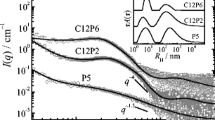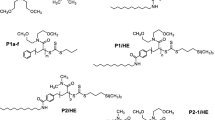Abstract
A series of poly(N,N-diethylacrylamide) samples with low molecular weights (1.9 × 103–5.3 × 104) and narrow polydispersities (below 1.5 and usually lower than 1.25) was synthesized by reversible addition-fragmentation chain transfer polymerization. The phase separation behavior of poly(N,N-diethylacrylamide) in aqueous solution was investigated by turbidimetry, fluorescent probe technology and DSC. It is interesting to find that the lower critical solution temperature (LCST) of the samples increases with increasing molecular weight and remains more or less a constant above a critical molecular weight of 1.2 × 104. At the same time, an inverse dependence of LCST on the concentration was found and this effect was more pronounced for lower molecular weight. To further investigate the novel molecular weight dependence of the LCST, the fluorescent probe study was conducted and the experimental results demonstrated that there was an increase in hydrophobicity when decreasing the molecular weight and increasing the concentration and flower-like micelles were probably formed which can further be proved by TEM.











Similar content being viewed by others
References
Privalov PL (1979) Stability of proteins small globular proteins. Adv Protein Chem 33:167–241. https://doi.org/10.1016/S0065-3233(08)60460-X
Privalov PL, Creighton TE (eds) (1992) In protein folding. W. H. Freeman & Co, New York, p 83
Privalov PL (1982) Stability of proteins: proteins which do not present a single cooperative system. Adv Protein Chem 35:1–104. https://doi.org/10.1016/S0065-3233(08)60468-4
Freire E, Murphy KP (1991) Molecular basis of co-operativity in protein folding. J Mol Biol 222:687–698. https://doi.org/10.1016/0022-2836(91)90505-Z
Bychkova VE, Berni R, Rossi GL, Kutyshenko VP, Ptitsyn OB (1992) Retinol-binding protein is in the molten globule state at low pH. Biochemistry 31:7566–7571. https://doi.org/10.1021/bi00148a018
Schild HG, Tirrell DA (1990) Microcalorimetric detection of lower critical solution temperatures in aqueous polymer solutions. J Phys Chem 94:4352–4356. https://doi.org/10.1021/j100373a088
Shunsuke K, Sokei S, Takahiro O, Tomohiro H, Koichi U, Cheng H, Tetsuo A (2017) NMR studies of water dynamics during sol-to-gel transition of poly(N-isopropylacrylamide) in concentrated aqueous solution. Polymer 109:287–296. https://doi.org/10.1016/j.polymer.2016.12.063
Takanori T, Tomohiro H, Koichi U, Yukiteru K, Taka-Aki A, Tatsuya S, Noboru K, Yasuyuki T (2016) Effects of syndiotacticity on the dynamic and static phase separation properties of poly(N-isopropylacrylamide) in aqueous solution. J Phys Chem B 120:7724–7730. https://doi.org/10.1021/acs.jpcb.6b03200
Fujishige S, Kubota K, Ando I (1989) Phase transition of aqueous solutions of poly(N-isopropylacrylamide) and poly(N-isopropylmethacrylamide). J Phys Chem 93:3311–3313. https://doi.org/10.1021/j100345a085
Kenji M, Tomonari S, Kenichiro K (2016) Liquid–liquid phase separation of N-isopropylpropionamide aqueous solutions above the lower critical solution temperature. Sci Rep 6:24657. https://doi.org/10.1038/srep24657
Wu C, Zhou SQ (1995) Laser light scattering study of the phase transition of poly(N-isopropylacrylamide) in water. 1. Single Chain. Macromolecules 28:8381–8387. https://doi.org/10.1021/ma00128a056
Zeng F, Zheng X, Tong Z (1998) Network formation in poly(N-isopropyl acrylamide)/water solutions during phase separation. Polymer 39:1249–1251. https://doi.org/10.1016/s0032-3861(97)00471-0
Lessard DG, Ousalem M, Zhu XX (2001) Effect of the molecular weight on the lower critical solution temperature of poly(N,N-diethylacrylamide) in aqueous solutions. Can J Chem 79:1870–1874. https://doi.org/10.1139/cjc-79-12-1870
Idziak I, Acoce D, Lessard D, Gravel D, Zhu XX (1999) Thermosensitivity of aqueous solutions of poly(N,N-diethylacrylamide). Macromolecules 32:1260–1263. https://doi.org/10.1021/ma981171f
Mitsuhiro M, Ryo W, Takanori T, Taka-Aki A, Tatsuya S, Noboru K, Yasuyuki T (2016) Rapid phase separation in aqueous solution of temperature-sensitive poly(N,N-diethylacrylamide). Macromol Chem Phys 217:2576–2583. https://doi.org/10.1002/macp.201600239
Plate NA, Lebedeva LI, Valuev LI (1999) Lower critical solution temperature in aqueous solutions of N-alkyl-substituted polyacrylamides. Polym J 31:21–27. https://doi.org/10.1295/polymj.31.21
Okano T (1993) Molecular design of temperature-responsive polymers as intelligent materials. Adv Polym Sci 110:179–197. https://doi.org/10.1007/BFb0021133
Miyajima M, Yoshida M, Sato H, Omichi H, Katakai R, Higuchi WI (1994) In vitro release of 9-β-d-arabinofuranosyladenine from thermo-responsive copoly(acryloyl-l-proline methyl ester/styrene) gels. Eur Polym J 30:827–831. https://doi.org/10.1016/0014-3057(94)90011-6
Chen JP, Hsu (1997) Preparations and properties of temperature-sensitive poly(N-isopropylacrylamide)-chymotrypsin conjugates. J Mol Catal B Enzym 2:233–241. https://doi.org/10.1016/s1381-1177(96)00032-x
Xue W, Champ S, Huglin MB (2001) New superabsorbent thermoreversible hydrogels. Polymer 42:2247–2250. https://doi.org/10.1016/S0032-3861(00)00550-4
Snowden MJ, Thomas D, Vincent B (1993) Use of colloidal microgels for the absorption of heavy metal and other ions from aqueous solution. Analyst 118:1367–1369. https://doi.org/10.1039/AN9931801367
Heskins M, Guillet JE (1968) Solution properties of poly(N-isopropylacrylamide). J Macromol Sci A2:1441–1455. https://doi.org/10.1080/10601326808051910
Taylor LD, Cerankowski LD (1975) Preparation of films exhibiting a balanced temperature dependence to permeation by aqueous solutions—a study of lower consolute behavior. J Polym Sci 11:2551–2570. https://doi.org/10.1002/pol.1975.170131113
Eliassaf J (1978) Aqueous solutions of poly(N-isopropylacrylamide). J Appl Polym Sci 22:873–874. https://doi.org/10.1002/app.1978.070220328
Lee LT, Cabane B (1997) Effects of surfactants on thermally collapsed poly(N-isopropylacrylamide) macromolecules. Macromolecules 30:6559–6566. https://doi.org/10.1021/ma9704469
Staikos G (1995) Viscometric study of the coil-globule transition of poly(N-isopropylacrylamide) in solutions of surfactant. Macromol Rapid Commun 16:913–917. https://doi.org/10.1002/marc.1995.030161206
Schild HG, Muthukumar M, Tirrell DA (1991) Cononsolvency in mixed aqueous solutions of poly(N-isopropylacrylamide). Macromolecules 24:948–952. https://doi.org/10.1021/ma00004a022
Tong Z, Zeng F, Zheng X (1999) Inverse molecular weight dependence of cloud points for aqueous poly(N-isopropylacrylamide) solutions. Macromolecules 32:4488–4490. https://doi.org/10.1021/ma990062d
Otake K, Karaki R, Ebina T, Yokoyama C, Takahashi S (1993) Pressure effects on the aggregation of poly(N-isopropylacrylamide) and poly(N-isopropylacrylamide-co-acrylic acid) in aqueous solutions. Macromolecules 26:2194–2197. https://doi.org/10.1021/ma00061a008
Xue W, Huglin MB, Jones TGJ (2003) Parameters affecting the lower critical solution temperature of linear and crosslinked poly(N-ethylacrylamide) in aqueous media. Macromol Chem Phys 204:1956–1965. https://doi.org/10.1002/macp.200300008
Zheng X, Tong Z, Xie XL, Zeng F (1998) Phase separation in poly(N-isopropyl acrylamide)/water solutions I. cloud point curves and microgelation. Polym J (Tokyo) 30:284–288. https://doi.org/10.1295/polymj.30.284
Elizaveta IT, Vladimir NU, Vanda BL, Stanislav IK, Valentina EB, Oleg BP (1995) ”Domain” coil-globule transition in homopolymers. Macromolecules 28:7519–7524. https://doi.org/10.1021/ma00126a032
Ru GY, Feng JW (2001) Effect of end groups on phase transition and segmental mobility of poly(N-isopropylacrylamide) chains in D2O. J Polym Sci B Polym Phys 49:749–755. https://doi.org/10.1002/polb.22237
Lazzari M, Liu GJ, Lecommandoux S (2006) Block copolymers in nanoscience. Wiley-VCH, Weinheim
Malmsten M (2002) Surfactants and polymers in drug delivery. Marcel Dekker, New York
Vasilieva YA, Thomas DB, Scales CW, McCormick CL (2004) Direct controlled polymerization of a cationic methacrylamido monomer in aqueous media via the RAFT process. Macromolecules 37:2728–2737. https://doi.org/10.1021/ma035574d
McCormick CL, Lowe AB (2004) Aqueous RAFT polymerization: recent developments in synthesis of functional water-soluble (co)polymers with controlled structures. Acc Chem Res 37:312–325. https://doi.org/10.1021/ar0302484
Thomas DB, Convertine AJ, Myrick LJ, Scales CW, Smith AE, Lowe AB, Vasilieva YA, Ayres N, McCormick CL (2004) Kinetics and molecular weight control of the polymerization of acrylamide via RAFT. Macromolecules 37:8941–8950. https://doi.org/10.1021/ma048199d
Donovan MS, Sumerlin BS, Lowe AB, McCormick CL (2002) Controlled/“living” polymerization of sulfobetaine monomers directly in aqueous media via RAFT. Macromolecules 35:8663–8666. https://doi.org/10.1021/ma0209996
Thomas DB, Sumerlin BS, Lowe AB, McCormick CL (2003) Conditions for facile, controlled RAFT polymerization of acrylamide in water. Macromolecules 36:1436–1439. https://doi.org/10.1021/ma025960f
Ganachaud F, Monteiro MJ, Gilbert RG (2000) Molecular weight characterization of poly(N-isopropylacrylamide) prepared by living free-radical polymerization. Macromolecules 33:6738–6745. https://doi.org/10.1021/ma0003102
Yang HJ, Cole CA, Monji N, Hoffman AS (1990) Preparation of a thermally phase-separating copolymer, poly(N-isopropylacrylamide-co-N-acryloxysuccinimide), with a controlled number of active esters per polymer chain. J Polym Sci Part A Polym Chem 28:219–226. https://doi.org/10.1002/pola.1990.080280116
Ganachaud F, Monteiro MJ, Gilber RG, Dourges MA, Thang SH, Rizzardo E (2000) Molecular weight characterization of poly(N-isopropylacrylamide) prepared by living free-radical polymerization. Macromolecules 33:6738–6745. https://doi.org/10.1021/ma0003102
Moad G, Rizzardo E, Thang SH (2008) Radical addition–fragmentation chemistry in polymer synthesis. Polymer 49:1079–1131. https://doi.org/10.1016/j.polymer.2007.11.020
Le TP, Moad G, Rizzardo E, Thang SH (1998) PCT Int Appl 9(801):478
Arotcaréna M, Heise B, Ishaya S, Laschewsky A (2002) Switching the Inside and the outside of aggregates of water-soluble block copolymers with double thermoresponsivity. J Am Chem Soc 124:3787–3793. https://doi.org/10.1021/ja012167d
Patterson D (1969) Free volume and polymer solubility. A qualitative view. Macromolecules 2:672–677. https://doi.org/10.1021/ma60012a021
Wang F, Saeki S, Yamaguchi T (1999) Absolute prediction of upper and lower critical solution temperatures in polymer/solvent systems based on corresponding state theory. Polymer 40:2779–2785. https://doi.org/10.1016/S0032-3861(98)00480-7
Liu Y, He JP, Xu JT, Fan DQ, Tang W, Yang YL (2005) Thermal decomposition of cumyl dithiobenzoate. Macromolecules 38:10332–10335. https://doi.org/10.1021/ma0513970
Pamies R, Zhu KZ, Nyström B (2009) Thermal response of low molecular weight poly-(N-isopropylacrylamide) polymers in aqueous solution. Polym Bull 62:487–502. https://doi.org/10.1007/s00289-008-0029-4
Malcolm GN, Rowlinson JS (1957) The thermodynamic properties of aqueous solutions of polyethylene glycol, polypropylene glycol and dioxane. Trans Faraday Soc 53:921–931. https://doi.org/10.1039/TF9575300921
Baulin VA, Halperin A (2002) Concentration dependence of the flory χ parameter within two-state models. Macromolecules 35:6432–6438. https://doi.org/10.1021/ma020296o
Matsuyama A, Tanaka F (1990) Theory of solvation-induced reentrant phase separation in polymer solutions. Phys Rev Lett 65:341–344. https://doi.org/10.1103/PhysRevLett.65.341
De Gennes PG (1991) A model for the tack of molten polymers. CR Acad Sci Paris Ser II 313:1415–1418
Painter PC, Berg LP, Veytsman B, Coleman MM (1997) Intramolecular screening in nondilute polymer solutions. Macromolecules 30:7529–7535. https://doi.org/10.1021/ma970792q
Kalyanasundaram K, Thomos JK (1997) Environmental effects on vibronic band intensities in pyrene monomer fluorescence and their application in studies of micellar systems. J Am Chem Soc 99:2039–2044. https://doi.org/10.1021/ja00449a004
Wilhelm M, Zhao CL, Wang YC, Xu RL, Winnik MA (1991) Poly(styrene-ethylene oxide) block copolymer micelle formation in water: a fluorescence probe study. Macromolecules 24:1033–1040. https://doi.org/10.1021/ma00005a010
Turro NJ, Grätzel M, Braun A (1980) Photophysical and photochemical processes in micellar systems. Angew Chem Int Ed Eng 19:675–696. https://doi.org/10.1002/anie.198006751
Tang WT, Hadziioannou G, Smith BA, Frank C (1988) Facile method for labelling polystyrene with various fluorescent dyes. Polymer 29:1313–1317. https://doi.org/10.1016/0032-3861(88)90062-6
Major MD, Torkelson JM, Brearly AM (1990) Fluorescence energy transfer studies of styrene-isoprene diblock copolymer solutions. Macromolecules 23:1700–1710. https://doi.org/10.1021/ma00208a025
Nagasaki Y, Okada T, Scholz C, Lijima M, Kato M, Kataoka K (1998) The reactive polymeric micelle based on an aldehyde-ended poly(ethylene glycol)/poly(lactide) block copolymer. Macromolecules 31:1473–1479. https://doi.org/10.1021/ma971294k
Astafieva I, Zhong XF, Eisenberg A (1993) Critical micellization phenomena in block polyelectrolyte solutions. Macromolecules 26:7339–7352. https://doi.org/10.1021/ma00078a034
Itakura M, Inomata K, Nose T (2000) Aggregation behavior of poly(N,N-diethylacrylamide) in aqueous solution. Polymer 41:8681–8687. https://doi.org/10.1016/S0032-3861(00)00267-6
Freitag R, Baltes T, Eggert M (1994) A comparison of thermoreactive water-soluble poly-N,N-diethylacrylamide prepared by anionic and by group transfer polymerization. J Polym Sci Part A Polym Chem 32:3019–3030. https://doi.org/10.1002/pola.1994.080321603
Acknowledgements
This research is supported by the National Natural Science Foundation (21404109) and Science Foundation of China University of Petroleum-Beijing at Karamay (RCYJ2016B-03-003, RCYJ2016B-02-005).
Author information
Authors and Affiliations
Corresponding author
Electronic supplementary material
Below is the link to the electronic supplementary material.
Rights and permissions
About this article
Cite this article
Wu, M., Zhang, H. & Liu, H. Study of phase separation behavior of poly(N,N-diethylacrylamide) in aqueous solution prepared by RAFT polymerization. Polym. Bull. 76, 825–848 (2019). https://doi.org/10.1007/s00289-018-2411-1
Received:
Revised:
Accepted:
Published:
Issue Date:
DOI: https://doi.org/10.1007/s00289-018-2411-1




